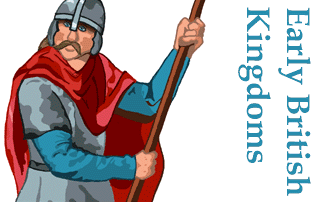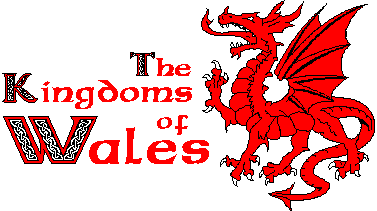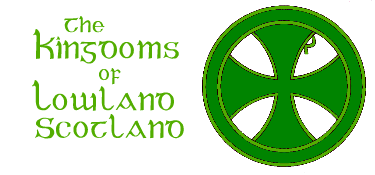
The kingdoms that occupied these isles before the present kingdoms - England and Scotland - and the Principality of Wales occupied them.
------------------------------------------------------------------------

The Kingdoms of what is now modern Wales came about by several means after Roman officialdom left the British shores. The Irish began to immigrate on a grand scale. The sons of the Emperor Magnus Maximus used them to keep control of Southern Wales. While North Wales was taken by Cunedda Wledig who was intent on driving the Irish out. Eastern Wales and the adjoining area of what became England was the homeland of the usurper, Vortigern, and here his sons continued to hold sway.
Magnus Maximus & South Wales
Magnus Maximus, or Macsen Wledig as he was known to the British, was a general in the Roman Army stationed in Wales. "Wledig" means Land-Holder or Imperator. His background, possibly maternal, was Spanish, but he was also said to have been a descendant of the Emperor Constantine the Great. As Roman control over the Western Empire began to break down in the late 4th century, Magnus was chosen by his men as Emperor of Britain & Gaul. He travelled to Gaul to pursue his claims but was killed in Italy in AD 388. His family remained behind in Britain and later took on the government of the major Roman towns in the Emperor's Welsh powerbase. Magnus' son, Constantine seems to have failed to establish a dynasty in Gwynedd; whilst Eugenius "Black-Lips" (alias Owain Finddu), founded the original dynasty of Mid-South Wales, later called Glywysing (alias Morgannwg). All other monarchies of South Wales descend from their brother Antonius Donatus Gregorius (alias Anwn Dynod). From Maximus descend the Kings of:
Glywysing (House of Finddu)
Dyfed
Brycheiniog
Gwent & Glywysing (House of Dynod)
Ergyng
--------------------------------------------------------------------------------
Cunedda & North Wales
Cunedda (or Cunedag) was a northern British chieftain, a sub-King of Gododdin who ruled Manau Gododdin on the Firth of Forth around Clackmannan. He was requested by the northern Welsh to help them expel the invading Irish from their lands, and he eagerly obliged. With his many 'sons,' Cunedda settled down in the area and founded a number of Royal dynasties:
Gwynedd
Rhôs
Ceredigion
Meirionydd
Dunoding
Dogfeiling
Rhufoniog
Edeyrnion
Afflogion
Osfeilion
--------------------------------------------------------------------------------
Vortigern & East Wales
Vortigern's family had lived in Glevum (Gloucester) before the Romans departed. Being a man of some influence in the town, Vortigern had managed to impose himself as the local leader in the area and, before long, he had taken control of the whole country as High-King of Britain. He is known to the Welsh as Gwrtheyrn Gwertheneu (Vortigern the Thin). As a man with no Imperial connections, he was viewed as a usurper by Roman legitimists, though he tried to consolidate his position by marrying a daughter of Magnus Maximus. His downfall is closely entwined with the story of the coming of the Saxons and the rise of the House of the great King Arthur. However, even after his death, his sons managed to retain control of his central power-base to the west and north of Gloucester, and founded the Kingdoms of:
Gwent (House of Fendigaid)
Powys
Buellt & Gwerthrynion
*****************************************************************************

The Kingdom of Dumnonia - occupied what is now Cornwall, Devon, Dorset and Somerset.
What we know today as the West Country - Cornwall, Devon, Somerset and Dorset - was once covered by a vast sub-Roman kingdom called Dumnonia. The name derives from the Celtic Iron Age & Roman-British tribe of the Dumnonii who lived in the two latter counties and the western part of Somerset. The name is retained today in Devon, the Saxon modern version derived from Defnas (the men of Devon) via the late-Celtic form, Dyfneint.
However, it is Cornwall, in the far west, which is usually thought of as the heartland of Celtic survival in this region. It appears to have been an area of semi-independence at times and, in later centuries, was certainly the last remnant of Dumnonia to be overrun by Saxon invaders. It is interesting to speculate about the name itself.
Cornwall may derive from the Celtic tribe of the Cornovii. A people of this name are known, from Roman sources, to have lived in the Outer Powys to Shropshire area of the later Wales and England. John Morris suggests a contingent was sent to the West Country in order to rule the land there and keep out the invading Irish. A similar situation occurred in North Wales. However, there is no evidence for this move west, and Cornish placenames of a similar age indicate that there was an independent tribe of Cornovii in the West Country. Corn is a common element in British place-name etymology, literally meaning Horn, but in this context a horn-shaped peninsula. It is the ideal description for Cornwall. The original name was Cerniw. The suffix is the same as the Saxon word Welsh, meaning foreign.
The Kings of Dumnonia, like their Saxon successors, were, no doubt, constantly on the move. One of their main Royal residences, perhaps a "Capital" of sorts, appears to have been the vast reoccupied Iron Age hillfort of Cadbury Castle in Somerset, probably named after the sixth century King Cado. Other important centres included Dunster and Tintagel. The status of these places may have changed over time. The latter, for instance, being very exposed, was probably a Summer residence only, perhaps sometimes left in the care of governors or duces like the legendary, Gorlois. At other times, it may have been the capital of the sub-kingdom of Cornwall.
There were a number of other such kingdoms extant at various times in Dumnonia, though details are often obscure. Sub-division of the Kingdom followed the traditional split between sons. This was certainly the case with Cornwall and, possibly, the legendary Lyonesse, centred on the Scilly Isles. Other regions were taken over by exiled Royalty from elsewhere, seeking a new power-base, forcibly or otherwise A little known kingdom, centred on the Hayle estuary, on the Penwith peninsula thus came under the control of King Tewdwr Mawr of Brittany; whilst a dynasty from Staffordshire established the sub-Kingdom of Glastening around Glastonbury in Somerset. Other regions on the eastern borders may have been completely independent of Dumnonia. Like the Kings of Caer-Baddan (Bath), the last of whom fell at the Battle of Dyrham in AD 577, or the otherwise unknown lords who have left ogham inscribed memorials at Wareham in Dorset.
The last King of Dumnonia, or Cornwall to which it had by then been reduced, was drowned in AD 875 and the West Country finally fell under full Saxon control. The area lost its language in the 19th century, but retains its Celtic identity even today.
**********************************************************************
THE BRITISH KINGDOMS OF
THE SOUTH
Southern Britain was the area most quickly overrun by the invading Saxon population. Only in the West Country did the Celtic spirit survive. Details of any South-Eastern British Kingdoms that may have emerged after the Roman exodus are therefore few and far between.
Modern Dorset
There may have been an independent kingdom here based on Caer Durnac (Dorchester, Dorset) or possibly Wareham, where several early British memorial stones have been discovered. Its name is unknown but may have been something like Dortrig.
Modern Hampshire
Other British Kingdoms probably existed in central southern Britain, the Saxon heartland. One possible King was Elaf(ius) the British leader whom St. Germanus met soon after his second landing in Britain in the 440s. He may have ruled the area round Caer Guinntguic (Winchester, Hampshire). Another possible King, Nudd, may have been the King Natanlaod killed by Cerdic at the Battle of Netley (Natanleag) in AD 508.
Caer Celemion (Silchester, Hampshire) was certainly a centre for British resistance, as indicated by the protective dykes surrounding its northern borders. Legends of a giant named Onion living there, may indicate a King called Einion.
Modern Kent
Before the mid-5th century High-King, Vortigern, so rashly gave the Kingdom of Ceint (modern-day Kent) away to the growing Saxon ranks in society, it was also a British Kingdom under a monarch named Gwyrangon. He was not best pleased to find his kingdom snatched from under him.
**************************************************************************************
THE BRITISH KINGDOMS OF THE
MIDLANDS
After the Roman administration departed Britain for Italy, the Mediterranean way of life certainly didn't disappear from the country overnight. In the Romano-British towns of the North and the West, prominent men rose to power and constructed little kingdoms for themselves, based on the Imperial model. Such kingdoms emerged in the midlands too, they were just less long lived. Details are, therefore, far more scarce.
Calchfynedd
Some of the descendants of the Northern King, Coel Hen, appear to have moved south and made their mark on Midland Britain. King Arthuis of the Pennines' youngest son, Cynfelyn, was one. His son, Cynwyd, found willing followers in the Chiltern Hills where he set up the Kingdom of Cynwidion, which was named after him. The appellation later changed to Calchfynedd (Chalk-Hills) during his son, Cadrod's reign. Though the exact area described is not known for sure, it was certainly south of Powys and tradition ascribes it the towns of Northampton and Dunstable. It may have been the precursor of Saxon Chilternset. Archaeological evidence indicates the British held out here well into the 7th century.
West Midlands
Adjoining kingdoms were probably based on old Roman cities. Caer Luit Coyt (Wall in Staffordshire) was supposedly from where the Kings of Glastening (Somerset) fled. Caer Guricon (Wroxeter, Shropshire) and Caer Magnis (Kenchester, Herefordshire) were eventually conquered by the Saxons and became the centres of the Kingdoms of Wrocenset and Magonset respectively. They may originally have been one kingdom, possibly part of Powys under the personal authority of High-King Vortigern. Later they would have been divided among sons in the traditional Celtic manner. Caer Guricon would have been the main centre. The town has provided the most extensive archaeological evidence for the 5th and 6th century survival of the Roman way of life.
Pengwern
Early the following century, one Constantine was ruling in this area, probably around Caer Magnis. His apparent brother, Cyndrwyn Fawr (the Great, though he was also called the Stubborn), ruled the lost Kingdom of Pengwern. He fought against King Aethelfirth of Bernicia at the Battle of Caer-Legion (Chester, Cheshire) in AD 613. His son, Cynddylan's capital, Llys Pengwern, is traditionally said to have been the Saxon foundation of Shrewsbury, though it could also have been the Berth at Baschurch, just to the north. There are indications that there was also an outpost at Din Guricon, the hillfort on the Wrekin overlooking Caer-Guricon (Wroxeter). A more defendable site than the old Roman town was evidently needed by this time. Cynddylan's exploits are remembered in the Marwnad Cynddylan and the Canu Heledd, the latter being a cycle of poems named after his sister, but erroneously said to have been composed by King Llywarch Hen of South Rheged. They tell of Heledd's lament at the destruction of the Kingdom of Pengwern, Cynddylan and his family. The King of Pengwern had faught alongside King Penda of Mercia against the invading Northumbrians, particularly at the AD 642 Battle of Maes Cogwy (Oswestry, Shropshire). Here their enemy, King Oswald, was killed. Fourteen years later, after Penda's death, Oswald's brother, Oswiu, found his way clear to wreak revenge on Cynddylan. He overran Llys Pengwern and the Penwernian King was brutally hacked down with several of his brothers. He was buried at Eglwysseu Bassa (Baschurch, Shropshire) and the Royal Court dispersed. Their old allies, the Mercians, later moved in and settled the area.
The Heart of Britain
Below Caer Magnis, lay the Romano-British cities of Caer Gloui (Gloucester, Gloucestershire), Caer Ceri (Cirencester, Gloucestershire) and Caer Baddan alias Aquaemann (Bath, Somerset). Small kingdoms were apparently set up here in the 5th century, but their last kings, Cynfael, Ffernfael and Cyndyddan respectively, were all killed fighting the West Saxons at the Battle of Dyrham (Gloucestershire) in 577. The two former realms may have been sub-kingdoms of Welsh Ergyng, as there are faint traditional associations. St. Aldate, Bishop of Gloucester was said to be a prince of Ergyng and, in an old tale, King Caradog Freichfras of Gwent held court at Cirencester. Caer Baddan may have been associated with Dumnonia.
**********************************************************************************

In the 5th century, after Britain had been forced to leave the Roman Empire, there was, as yet, no England (named after the Anglo-Saxons), no Wales (a Saxon word for place of the foreigners) and no Scotland (named after the Scotti from Ireland). What is now modern Scotland was then divided into three distinct areas:
Pictland: The northern region where the (probably non-Celtic) picts lived
Dalriada: The area around Argyle where the (Q-Celtic) Scotii originally settled before they came to dominate the whole region.
Lowland British Kingdoms: The land between the Roman Walls of Hadrian & Antoninus Pius inhabited by the (P-)Celtic peoples who had been under Roman jurisdiction for only twenty-four years between AD 138 & 162.
The lowland British Kingdoms essentially stemmed from two sources. The Kingdom of Gododdin, centred on Trapain Law in Lothian, emerged under a leading family from the local tribe of the Votadini (after whom the kingdom was named). It was later called Lothian, after its most famous monarch, King Lot of Arthurian tradition.
Most of the region, however, was ruled over by descendants of Ceretic Guletic (the Land-Holder or Imperator), an early 5th century character well-known for his reprimand from St. Patrick. The elder dynasty held the Overlordship of Strathclyde. Whilst younger branches established sub-kingdoms in the tribal home of the Selgovae (around Selkirk) and in Galloway & Ynys Manaw (Strathclyde). There was some confusion in the early genealogies of these kings. Later monarchs appear to have rejected their descent from Ceretic in favour of claiming the more prestigious Magnus Maximus as their ancestor.
Strathclyde was the most durable of British Kingdoms outside Wales & Brittany. It survived well into the late 9th century, when intermarriage with the ruling House of Scots led to a merging of the two realms.

British kingdoms, circa 450 AD.
britannia.com